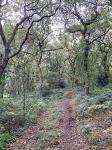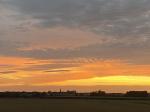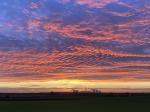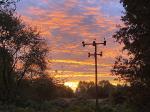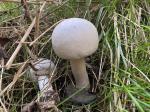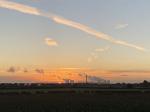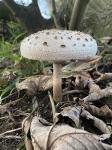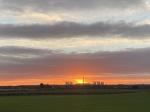Brayton Barff Through the Seasons.
Set in the Vale of York, South West of the market town of Selby and between the villages of Thorpe Willoughby and Brayton, lies Brayton Barff, a sandstone Hill approximately one hundred and fifty feet in height which was formed by glacial movement during the last Ice Age. It is a significant landmark in an otherwise flat landscape.
Today the site is primarily owned by Yorkshire Water with Selby District Council owning a small patch of the land adjacent to the A63 Selby bypass. A large underground reservoir occupies the centre of the site which delivers water to around 4.7 million customers throughout Yorkshire.
Within the Barff woodland over 40% of the trees are Sessile Oak which are generally found in semi natural woodlands in the north of the country. These trees are so called because its acorns are not held on stalks, like those of the English Oak (Pedunculate), but attached directly to the outer twigs. There are also several English Oak trees as well as some cross-hybrid oaks. These trees are known to support many species of flora and fauna, invertebrates, mosses, lichen and fungi.
During the Victorian times it is thought that the shipbuilders on the east coast would come over to the Barff for selected cuts of timber to build their sea going vessels.
The Barff also has a variety of other trees including Silver Birch, Beech, Sycamore, Holly, Rowan, Scots Pine, Alder, Hawthorne and European Larch. There are also several Yew, Willow, Hazel, Horse Chestnut and Wych Elm. As with similar woodlands there are a variety of bushes, including Honeysuckle, Elderberry, Gorse, Broom and Buddleia.
The history of Brayton Barff is quite vague, apparently during 1803 a beacon was lit on the Barff when the country was threatened with an invasion by Napoleon. In May 1935, to celebrate King George V's Silver Jubilee, a Bonfire was lit on the Barff as part of the celebrations.
Early issues of Ordnance Survey Maps dated 1903 clearly show a rifle range on the Barff, extending out to Mill Lane. During the 
Between 2001 – 2004 the A63 Selby bypass, 10km twin lane single carriageway was constructed which severed the South West corner of the Barff, adjacent to Selby Golf Course and resulted in a slight redesign of several holes on the golf course. Wooden fencing was erected as a result of this new road running alongside of the Barff and a footbridge constructed over the ‘new road’ following the line of the Bridal way which extends from Mill Lane. Around 2005/2006 a definite 2metre wide limestone aggregate footpath was laid forming a circular path around the outer edges of the woodland. This footpath is approximately 1.2 miles in length and takes about 30 minutes to circumnavigate at a leisurely pace.
In 2012 the Barff was declared an Ancient Oak Woodland and as such throughout 2012 and 2013 significant work had been carried out by the relevant agencies to cut and remove large swathes of non-native trees, creating at that time huge scars on the landscape. Some three years later the planting of the native trees have become well established and are flourishing. Ongoing maintenance work on the footpath around the bottom of the Barff was completed during the Summer of 2016.
A second phase of woodland maintenance commenced during the Autumn of 2019 with the removal of many old and diseased trees and the cutting back of the Gorse and Broom bushes, especially adjacent to the ‘bypass trail’, this work continued through till March 2020 with re planting continuing into April 2020.
Brayton Barff is a popular site for walkers and bird watchers alike and a path circling the outer perimeter of the Barff makes a pleasant thirty minute walk, giving views looking over towards Selby and the village of Brayton as well as the power stations of Drax and Eggborough..jpg)
For the early risers it is a great place to see some stunning sunrises over the villages of Brayton looking towards Drax Power Station, the same with the Sunsets looking over towards Eggborough and Monk Fryston.
The Barff changes with the Seasons and every visit can reveal something new, the woodland is a haven for wildlife. Records show that since 1982 one hundred and twelve species of bird have been seen in the woodland and at least 40 of those have bred here, including Tawny Owl, Buzzard, Green Woodpecker, Spotted Flycatcher, Goldcrest and Nuthatch to name just a few. On average over 70 species of bird are recorded each year. Further details of the bird life on the Barff can be found on the Brayton Barff Group Facebook page, especially the posts from Derek Cooper. Today ‘The Friends of Brayton Barff group’ led by Derek and a small team of volunteers help keep and maintain the cleanliness of the site as well as recording the wildlife and bird sightings.
The Barff is also home to fifteen different species of mammals, including Muntjac Deer, Pipistrelle Bat, Fox, and Field Vole.
Over eighty species of plant and wildflowers have been recorded, included Bee Orchid, Northern Marsh Orchid, Wood Anemone, Marsh Ragwort, Bluebell, White Bluebell, Bittersweet and Purple and White Foxgloves. Over twenty species of Butterfly have been recorded, including Marbled White, Brown Angus, Speckled Wood, Comma and Brimstone.
During the Autumnal months fungi thrives in this woodland environment, species including Fly Agaric, Beefsteak Tree Fungi, Chicken of the Wood, Sulphur Tufts, Stinkhorn, Ink cap, Puffballs and Hoof Bracket are just some of the many varieties that can be found here.
Click on the galleries shown below to expand the albums.
October 2021
I have to say, I quite enjoy Autumn on the Barff, there is so much going on at this time of year. The trees are preparing for winter, shedding their leaves after they have turned a beautiful shade of yellow and gold, littering the woodland floor in a golden blanket.
The weather for most of October has been quite unsettled and wet, though there was a drier spell between the 8th and 17th. Fortunately, most of the rain fell at night, making for some wet morning dog walks. Temperatures for October were slightly above average for most of the month and although the morning temperatures at times were quite chilly we haven’t yet had any overnight frosts and I have not started wearing any of my winter clothing. I have to say that sunshine has been in short supply, and most have our morning dog walks have been dull and overcast. That said, we have had some lovely sunrises, albeit short lived before the clouds rolled in and blotted it out after just a few minutes.
The daytime temperature for October has been just about a degree above the average for this time of year which has resulted in a bumper year for fungi on the Barff.
On the other hand, we have had a poor year for acorns, apparently the reason being that last year was what is known as a ‘mast year’. A mast year occurs roughly once every 5-10 years and is where a tree species such as oak drastically increase the number of acorns they produce. The oak trees put so much energy into this bumper crop of acorns that they leave themselves little energy to continue producing the following years. So, since last year was a mast year, this year our oaks are recovering resulting in far fewer acorns, I have seen several Grey Squirrels running around the Barff having been on a raiding mission in the adjoining field which is full of Maize, lets hope that this will be sufficient to sustain them through the colder winter months. It will be interesting to see how our Jays manage with the lack of Acorns too.
On the bird front, most of our overseas visitors have now left for warmer climes, Chiffchaff and Blackcaps especially, along with Swallows and House Martins. There are still several Great Spotted Woodpeckers, Nuthatch, Great & Blue Tits, Robin and Thrush around and they will over winter with us, along with Chaffinch, Wren, Dunnocks and Bullfinches.
On the 9th October I was up early and on the Barff for around 6.15am, it was pitch black, I was following the track under the old Oak swing tree, adjacent to the old pump house, I could hear the Tawny Owl loudly as I walked under the tree, it was hunting around that area, as I looked down in amongst the grass my headlamp picked out a pair of voles trying to scamper along the ground into the protection of the bramble bushes, unfortunately both creatures looked to be very badly injured with significant wounds on their backs which I have to presume were caused by the Tawny Owl, I must have disturbed it as I was walking past the tree, it panicked as I came near, dropped its prey and flew up into the tree, waiting till I had walked through the area, before it returned to retrieve its prey.
Towards the end of the month, the Yorkshire Water contractors finished their work on the top of Tap hill, I am not sure what they have been doing due to the area being fenced off, but they created a huge pile of earth and subsequently relaid it all again, I had a look once all the fencing had been removed and the contractors look to have levelled off the area quite nicely, unfortunately the tracks that ran across this area were heavily overgrown with bramble briars and quite impregnable. I doubt it will be next Spring before the land starts to recover.
I mentioned earlier that October has been a bumper month for fungi, Puffballs have been in abundance now for several month and are or appear to be all over the woodland floor, clumps of Sulphur Tuft form tiny toadstools on the end of decaying silver birch trees, Birch Polypore are forming on decaying silver birch trees, there are lots of Shaggy Parasols and Stinkhorn too. One of my favourite looking fungi is the colourful Fly Agaric, and although I have not spotted any on my regular walk on the woodland, once I follow a different route there are several, hidden amongst the heavy undergrowth at the side of the track.
As the month came to an end, strong winds continue to batter the woodland, if they continue for much longer most of the leaves will have died back and the trees bare, ready for the onset of the winter months.
|





